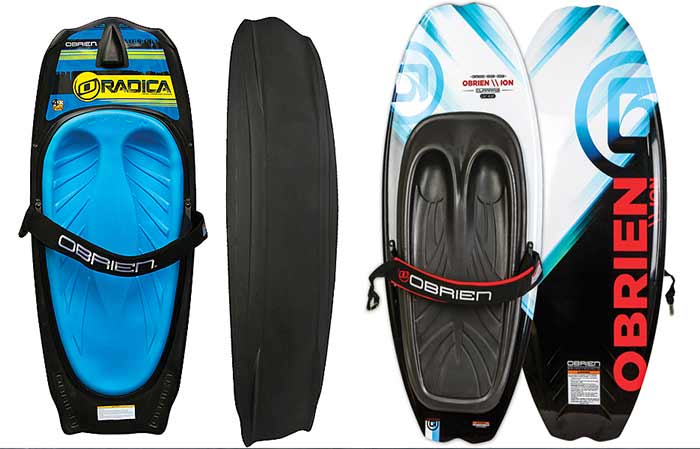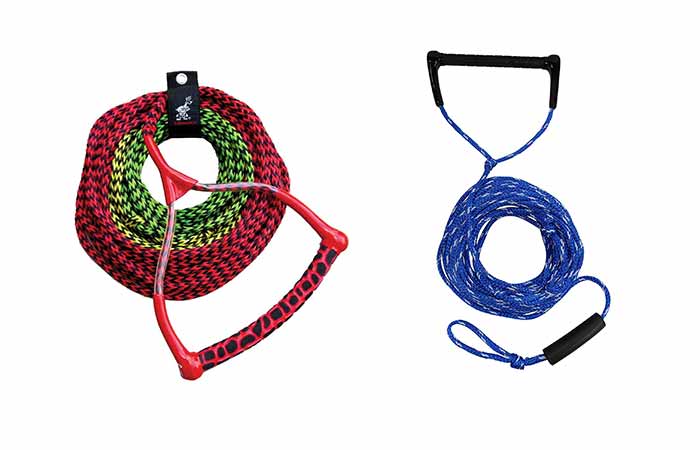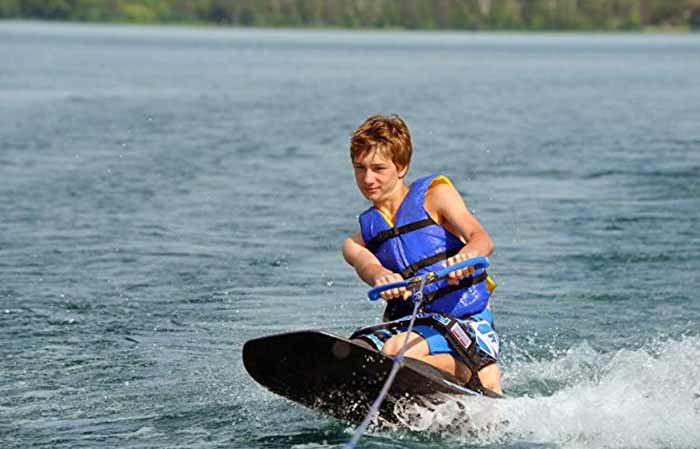Kneeboarding vs Wakeboarding: Which for me?
Among the most popular water sports are kneeboarding and wakeboarding which are almost similar yet have their distinctive traits as well. Most people easily transition between the two without an issue. However, rookies may need to select one to start with or pursue.
The choice between the two sports depends on your experience on the water and other individualistic issues. For example, if you’re new to the sport and need a sport with less risks, go for kneeboarding since you’re closer to the water surface.
If, however, your aim is to have as much fun as possible and you’re comfortable on the water, go for wakeboarding. Also, kneeboarding is best suited to lakes and other smaller water bodies while wakeboarding can handle waves in the sea and similarly larger bodies.
As seen here, your level of expertise on the water and the water body available play major roles in helping you choose what water sport you go for. Other than that, these sports are almost similar to each other.
As a newbie, however, you’re safer starting out with kneeboarding then advancing to wakeboarding then ditching the tow rope afterwards if you please.
Kneeboarding vs Wakeboarding: Differences
The two sports have a relatively long list of differences even when they’re basically the same thing. They include the following:
1. Form
The most evident difference between them is the form you assume when riding the board. Kneeboarding entails kneeling on the board as you’re pulled by the tow boat while wakeboarding has you standing on the board still being towed by the boat.
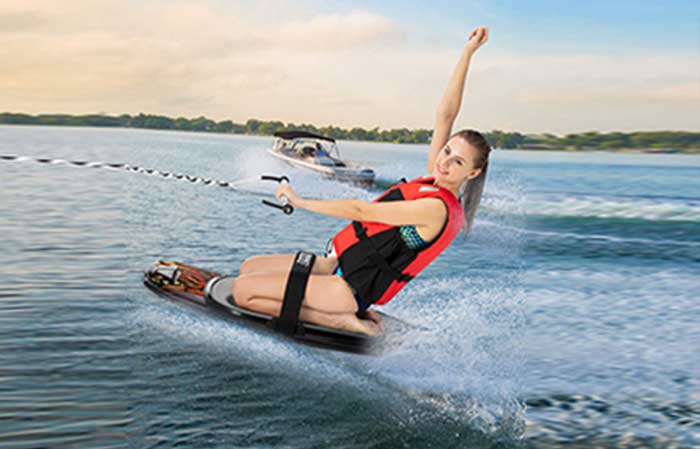

Also, kneeboarding mostly entails facing forward in the direction of the tow boat. You also hold unto the tow rope handle with both hands in kneeboarding. With wakeboarding, you’ll be mostly facing sideways and holding unto the tow rope handle with one hand.
2. Boards
The kneeboard and the wakeboard are different in shape and size given the difference in the posture of the body.
Kneeboards are long, almost flat and thick to increase their buoyancy while wakeboards are thin, curved upwards and shorter than the kneeboards to allow for easy maneuverability.

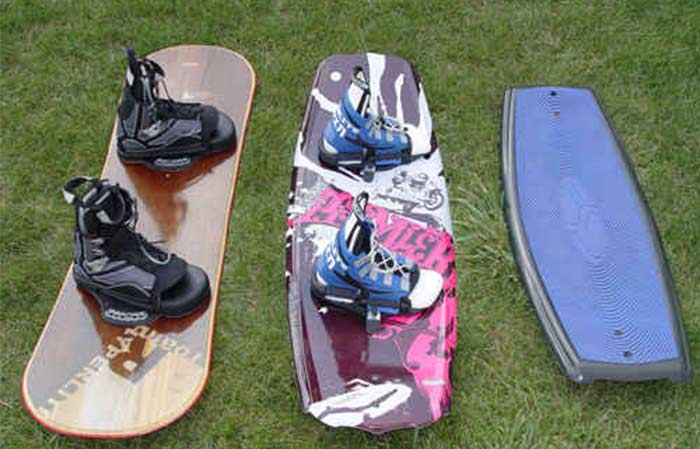
Kneeboards are between 5 to 6 feet while a wakeboard ranges between 4 and 5 feet. Generally, the height of a kneeboard is to be about your height for the best control of the board.
Beyond that, the grooves on the boards are different. The kneeboard has two wide grooves to accommodate the knees while the wakeboards have smaller shoe-like grooves for the feet.
3. Speed
While the speed range for both sports is 15 to 20 mph, you can go much faster with the wakeboard than with the surfboard. Given also that wakeboarding will often occur in larger water bodies, attaining speeds as much 30 mph or even higher is common for experienced surfers.
4. Difficulty
Kneeboarding is favored by rookies over other water sports such as wakeboarding and surfing owing to being easier to learn. The fact that the body is closer to the water means that you can control it better and falls are less severe.
Wakeboarding, on the other hand, presents another level of difficulty having to control the lighter (and less buoyant) board with your feet on the water at a speed.
5. Tricks Possible
While both kneeboarding and wakeboarding have a long list of tricks one can perform, wakeboarding offers the rider a better position to perform the more complex ones far much easier. Being on your knees while attempting some complex tricks is tougher than the freedom afforded by being on your feet.
6. Ease of Transition to Other Water Sports
While kneeboarding is easier, you’ll still have a major task entering other sports that require standing up and letting go of the tow rope. Wakeboarding better prepares you for the the faster and more complex water sports than does kneeboarding.
Even with these differences, there isn’t a major aspect to completely separate the sports.
Similarities Between Kneeboarding and Wakeboarding
The sports are similar in the following ways:
1. Tow Rope
Both require the rider to be towed by a tow boat. That means that, unlike surfing, the forward motion is provided by the boat rather than wind or the waves alone. For this reason, you’re quite safe with either sport as there’s also an observer and the tow boat driver with you.
The length, type and size of the tow ropes in either sport are also similar. You can choose between various handles but they’re also the same for both sports.
2. Tow Speed
Both sports use speeds of between 15 to 20 mph. You can, however, attain faster speeds with wakeboarding once you get the hang of it.
The speeds are comfortable for both rookies and experts. Wakeboarding can however go as much as 30 mph especially for experts.
3. Safety
For both sports, the safety requirements are the same. These include the following:
- Never engage in the sport without a life vest.
- Avoid falling forwards as much as possible. Rather, fall to the sides and backwards to avoid injuries from hitting yourself on the board.
- Ensure you have the right equipment before going on the boat. The equipment should also be in good working condition first.
- Avoid engaging in the sport around other swimmers, docks, land, shallow waters, or boats to avoid injury.
- Only signal the tow boat to start moving when you’re ready.
- Avoid wrapping the handle on any part of your body.
- Learn the hand signals before going on the water.
These will keep you safe even in other sports beyond the two in question.
4. Start and Finish
For either sport, the start and finish routine is the same. At the beginning, you lie on your belly on the board while holding unto the tow rope and the board itself.
You then slowly rise to the natural position for each sport (knees for kneeboarding and feet for wakeboarding). At the end of the activity, you simply disembark from the board and carry it with you out of the water.
5. Surfing without Tow Rope
For both types of sports, there are versions in which you can surf without being pulled by the tow boat and instead riding the waves like in surfing. Everything from the boards to the position on the board remains the same.
These similarities point to the fact that these sports are basically the same save for your posture.
Which is Best for me and why
The decision to choose between kneeboarding and wakeboarding will be based on the following aspects:
Experience
If you’re a newbie to water sports, you’re much better off starting with kneeboarding as it poses less risks.
Desired speed
You can afford a higher speed with a wakeboard than a kneeboard. However, the average speed of between 15 to 20 mph is enough for most people.
Physical fitness
If you have joint issues such as arthritis, you’ll find it hard kneeling on the kneeboard for long. On the other hand, you need great stability in your legs to balance and do tricks with the wakeboard.
Personal choice:
Your preference on the sport you prefer is also a major factor. Transitioning from one sport to the other in this comparison only requires a change of board. Otherwise, everything remains the same.
As such, picking one sport from the other shouldn’t be an issue. However, wakeboarding is more popular than kneeboarding as seen by the number of people engaging in it.
Further Reading


